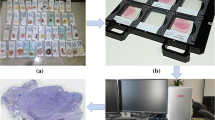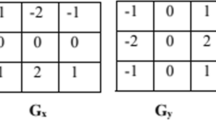Abstract
Digital image processing is turning out to be increasingly more significant in the health care field used to diagnose skin cancer. The death rate is increasing by 1% every year due to skin cancer. One of the major causes of casualties due to this cancer is the non-predictability at the early stages. This paper will help in future research work when it comes to early detection of a tumor. In this work, the proposed model comprises of two important steps which are preprocessing and segmentation. In a pre-processing case, unwanted artifacts like hair, illumination, or many other artifacts are reduced by an enhanced technique using threshold and morphological operations and In the second step, segmentation of skin lesion using k-mean segmentation algorithm with optimized firefly algorithm (FFA) technique is used to achieve high accuracy. Input sample images are taken from the International skin imaging collaboration (ISIC) archive dataset and dermatology service of Hospital Pedro Hispano (PH2) dataset which are available online. The results of the proposed method are measured in terms of different parameters. It provides an accuracy of 99.1% and 98.9% using ISIC and PH2 datasets and shows better performance than existing techniques such as K-Mean and K-Mean with Particle Swarm Optimization (PSO). The performance of this research work is, in fact, quite promising.






Similar content being viewed by others
References
Abbas Q, Fondón I, Rashid M (2011) Unsupervised skin lesions border detection via two-dimensional image analysis. Comp Methods Prog Biomed 104(3). https://doi.org/10.1016/j.cmpb.2010.06.016
Abbas Q, Celebi ME, García IF, Rashid M (2011) Lesion border detection in dermoscopy images using dynamic programming. Skin Res Technol 17(1):91–100
Abbas Q, Celebi M, García IF (2011) Hair removal methods: a comparative study for dermoscopy images. Biomed Signal Process Control 6(4):395–404. https://doi.org/10.1016/j.bspc.2011.01.003
Ahn E, Kim J, Bi L, Kumar A, Li C, Fulham M, Feng DD (2017) Saliency-based lesion segmentation via background detection in Dermoscopic images. IEEE J Biomed Health Informat 21(6):1685–1693
Bi L, Kim J, Ahn E, Feng D, Fulham M (2016) Automated skin lesion segmentation via image-wise supervised learning and multi-scale superpixel based cellular automata. In: 2016 IEEE 13th International Symposium on Biomedical Imaging (ISBI), Prague, Czech Republic. https://doi.org/10.1109/ISBI.2016.7493448
Bi L, Kim J, Ahn E, Kumar A, Fulham M, Feng D (2017) Dermoscopic image segmentation via multistage fully convolutional networks. IEEE Trans Biomed Eng 64(9):2065–2074
Bozorgtabar B, Sedai S, Roy PK, Garnavi R (2017) Skin lesion segmentation using deep convolution networks guided by local unsupervised learning. IBM J Res Dev 61(4/5). https://doi.org/10.1147/JRD.2017.2708283
Celebi ME, Zornberg A (2014) Automated quantification of clinically significant colors in Dermoscopy images and its application to skin lesion classification. IEEE Syst J 8(3):980–984. https://doi.org/10.1109/JSYST.2014.2313671
Celebi ME, Kingravi HA, Iyatomi H, Aslandogan YA, Stoecker WV, Moss RH, Malters JM, Grichnik JM, Marghoob AA, Rabinovitz HS, Menzies SW (2008) Border detection in dermoscopy images using statistical region merging. Skin Res Technol 14(3):347–353
Celebi M, Iyatomi H, Schaefer G, Stoecker WV (2009) Lesion border detection in dermoscopy images. Comput Med Imaging Graph 33(2):148–153
Celebi ME, Wen Q, Hwang S, Iyatomi H, Schaefer G (2012) Lesion Border Detection in Dermoscopy Images Using Ensembles of Thresholding Methods. Skin Res Technol 19(1). https://doi.org/10.1111/j.1600-0846.2012.00636.x
Codella NCF, Gutman D, Celebi ME, Helba B, Marchetti MA, Dusza SW, Kalloo A, Liopyris K, Mishra N, Kittler H, Halpern A (2016) Skin lesion analysis toward melanoma detection. In: International symposium on biomedical imaging (ISBI), Prague, Czech Republic
Eltayef K, Li Y, Liu X (2017) Lesion Segmentation in Dermoscopy Images Using Particle Swarm Optimization and Markov Random Field. In: IEEE 30th International Symposium on Computer-Based Medical Systems (CBMS), Thessaloniki, Greece. https://doi.org/10.1109/CBMS.2017.26
Fan H, Xie F, Li Y, Jiang Z, Liu J (2017) Automatic segmentation of dermoscopy images using saliency combined with Otsu threshold. Comput Biol Med 85:75–85
Fleming MG, Steger CB, Zhang JR, Gao J, Cognetta A, Pollak L, Dyer C (1998) Techniques for a structural analysis of dermatoscopic imagery. Comput Med Imaging Graph 22(5):375–389
RB Francisco, MFP Costa, Rocha AMAC (2014) Experiments with Firefly Algorithm. Computational Science and Its Applications – 14th International Conference on Computational Science and Its Applications (ICCSA ), Guimaraes, Russia. https://doi.org/10.1007/978-3-319-09129-7_17
Garnavi R, Aldeen M, Celebi ME, Varigos G, Finch S (2011) Border detection in dermoscopy images using hybrid thresholding on optimized color channels. Comput Med Imaging Graph 35(2):105–115
George Y, Aldeen M, Garnavi R (2015) Skin Hair Removal for 2D Psoriasis Images,” 2015 International Conference on Digital Image Computing: Techniques and Applications (DICTA), Adelaide, SA. https://doi.org/10.1109/DICTA.2015.7371308
Ghamisi P, Couceiro MS, Benediktsson JA, Ferreira NM (2012) An efficient method for segmentation of images based on fractional calculus and natural selection. Expert Syst Appl 39(16):12407–12417
Gomez DD, Butakoff C, Ersboll BK, Stoecker W (2007) Independent histogram pursuit for segmentation of skin lesions. IEEE Trans Biomed Eng 55(1):157–161. https://doi.org/10.1109/TBME.2007.910651
Grin CM (1990) Accuracy in the Clinical Diagnosis of Malignant Melanoma. Arch Dermatol 126(6):763
Iyatomi H, Oka H, Saito M, Miyake A, Kimoto M, Yamagami J, Kobayashi S, Tanikawa A, Hagiwara M, Ogawa K, Argenziano G, Soyer HP, Tanaka M (2006) Quantitative assessment of tumour extraction from dermoscopy images and evaluation of computer-based extraction methods for an automatic melanoma diagnostic system. Melanoma Res 16(2):183–190
Jafari M, Karimi N, Nasr-Esfahani E, Samavi S, Soroushmehr S, Ward K, Najarian K, (2016) Skin lesion segmentation in clinical images using deep learning. In: 23rd International Conference on Pattern Recognition (ICPR), Cancun, Mexico. https://doi.org/10.1109/ICPR.2016.7899656
Jaisakthi SM, Mirunalini P, Aravindan C (2018) Automated skin lesion segmentation of dermoscopic images using GrabCut and k-means algorithms. IET Comput Vis 12(8):1088–1095. https://doi.org/10.1049/iet-cvi.2018.5289
Kechichian R, Gong H, Revenu M, Lezoray O, Desvignes M (2014) New data model for graph-cut segmentation: Application to automatic melanoma delineation. In: 2014 IEEE International Conference on Image Processing (ICIP), Paris, France, https://doi.org/10.1109/ICIP.2014.7025179
Ma Z, Tavares JMRS (2015) A novel approach to segment skin lesions in Dermoscopic images based on a deformable model. IEEE J Biomed Health Informat 20(2):615–623
Maglogiannis I, Delibasis K (2015) Hair removal on dermoscopy images. In: 37th Annual International Conference of the IEEE Engineering in Medicine and Biology Society (EMBC), Milan, Italy. https://doi.org/10.1109/EMBC.2015.7319013
Morton, Mackie (1998) Clinical accuracy of the diagnosis of cutaneous malignant melanoma. Br J Dermatol 138(2):283–287
Nayak J, Naik B, Behera HS (2017) Cluster analysis using firefly-based K-means algorithm: a combined approach. Adv Intell Syst Comput Comput Intell Data Mining:55–64. https://doi.org/10.1007/978-981-10-3874-7_6
Nock R, Nielsen F (2004) Statistical region merging. IEEE Trans Pattern Anal Mach Intell 26(11):1452–1458
Pennisi A, Bloisi DD, Nardi D, Giampetruzzi AR, Mondino C, Facchiano A (Sep. 2016) Skin lesion image segmentation using Delaunay triangulation for melanoma detection. Comput Med Imaging Graph 52:89–103
Sadri AR, Zekri M, Sadri S, Gheissari N, Mokhtari M, Kolahdouzan F (2012) Segmentation of Dermoscopy images using wavelet networks. IEEE Trans Biomed Eng 60(4):1134–1141
Silveira M, Nascimento JC, Marques JS, Marcal ARS, Mendonca T, Yamauchi S, Maeda J, Rozeira J (2009) Comparison of segmentation methods for melanoma diagnosis in Dermoscopy images. IEEE J Select Topics Signal Process 3(1):35–45. https://doi.org/10.1109/JSTSP.2008.2011119
Suer S, Kockara S, Mete M (2011) An improved border detection in dermoscopy images for density based clustering. In: Proceedings of the Eighth Annual MCBIOS Conf., Texas, US. https://doi.org/10.1186/1471-2105-12-S10-S12
Toossi MTB, Pourreza HR, Zare H, Sigari M-H, Layegh P, Azimi A (Apr. 2013) An effective hair removal algorithm for dermoscopy images. Skin Res Technol 19(3):230–235
Toossi MTB, Pourreza HR, Zare H, Sigari M-H, Layegh P, Azimi A (2013) An effective hair removal algorithm for dermoscopy images. Skin Res Technol 19(3):230–235
Xie F, Bovik AC (2013) Automatic segmentation of dermoscopy images using self-generating neural networks seeded by genetic algorithm. Pattern Recogn 46(3):1012–1019. https://doi.org/10.1016/j.patcog.2012.08.012
Yu L, Chen H, Dou Q, Qin J, Heng P-A (2016) Automated melanoma recognition in Dermoscopy images via very deep residual networks. IEEE Trans Med Imaging 36(4):994–1004
Yuksel M, Borlu M (2009) Accurate segmentation of Dermoscopic images by image Thresholding based on Type-2 fuzzy logic. IEEE Trans Fuzzy Syst 17(4):976–982. https://doi.org/10.1109/TFUZZ.2009.2018300
Zhou H, Schaefer G, Sadka AH, Celebi ME (2009) Anisotropic mean shift based fuzzy C-means segmentation of Dermoscopy images. IEEE J Select Topics Signal Process 3(1):26–34. https://doi.org/10.1109/JSTSP.2008.2010631
Author information
Authors and Affiliations
Corresponding author
Additional information
Publisher’s note
Springer Nature remains neutral with regard to jurisdictional claims in published maps and institutional affiliations.
Rights and permissions
About this article
Cite this article
Garg, S., Jindal, B. Skin lesion segmentation using k-mean and optimized fire fly algorithm. Multimed Tools Appl 80, 7397–7410 (2021). https://doi.org/10.1007/s11042-020-10064-8
Received:
Revised:
Accepted:
Published:
Issue Date:
DOI: https://doi.org/10.1007/s11042-020-10064-8




